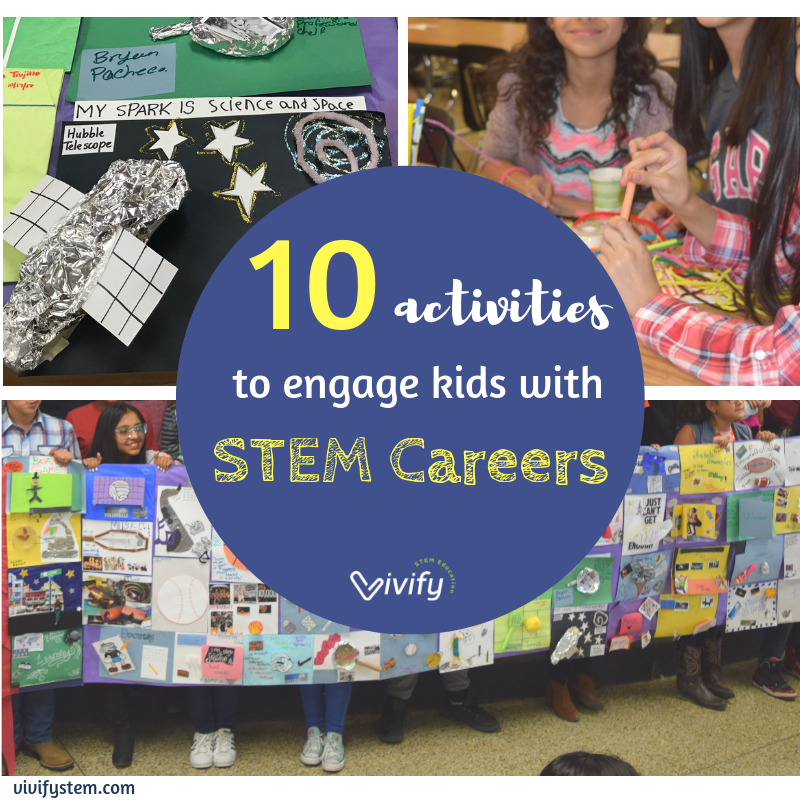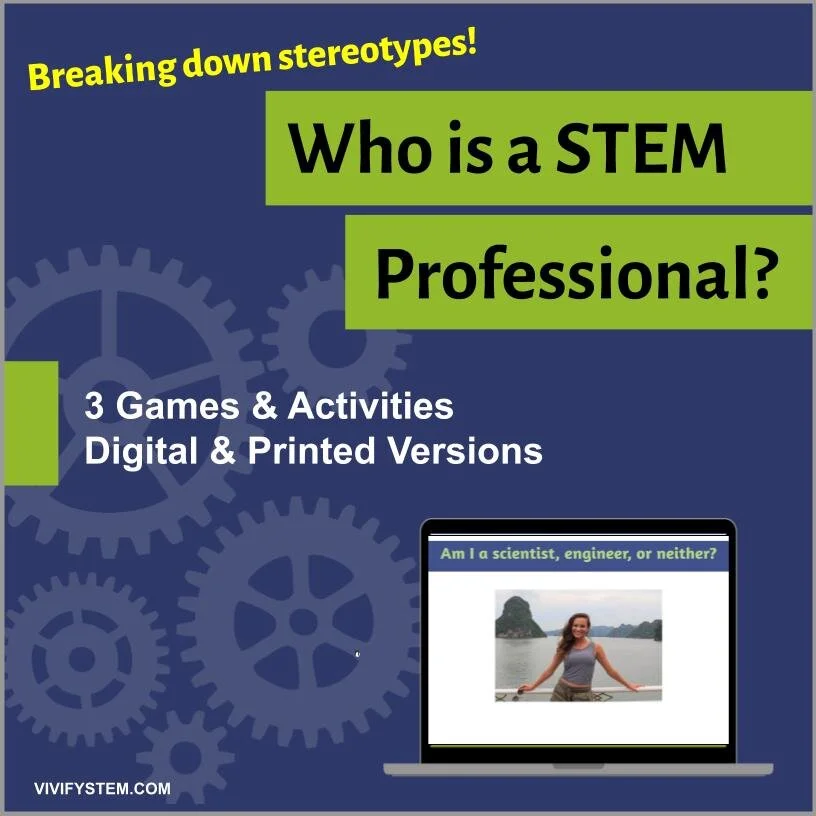10 Easy STEM Career Classroom Activities
Originally Posted: August 1, 2019
Updated: February 2024
Let’s talk careers. STEM careers are the fastest growing of any other field out there. Did you know there are more openings for STEM jobs than we have qualified workers to fill them? Plus 93% of STEM jobs earn wages that are nearly double the national average (source). Do your students know about these opportunities? The high wages and abundant opportunities are exactly why the STEM education movement exists!
Do you talk about STEM careers in your classroom? This is definitely an overlooked topic as careers aren’t on a standardized test. But the real world is beyond the test. We need to prepare our students for the demands and required skills of the 21st century workplace.
How do I start? Many educators have limited knowledge of STEM careers or real-world topics. They feel intimidated or overwhelmed. Or maybe they know about certain careers, but they are looking to expand their knowledge of the diverse field.
We can help! Read on for strategies to bring STEM careers to life in your classroom! Through activities that connect STEM to student interests, we will show you how to engage kids with the exciting possibilities of real-world STEM.
Step 1: Find Student Sparks
You can go on and on about engineering, but how do you get students to actually listen? They will only take notice if you find a way to connect STEM to their personal interests. By taking a students’ passion and connecting it to a STEM career, it can help redefine what that career means to them.
The best approach we found was through the use of sparks. A spark is what a student is passionate about, what lights them up and gives them well......that “spark”. Sparks were developed by the Search Institute, who explains them as follows:
“Sparks are the activities and interests that truly engage kids to be their best. Research shows that kids who know and develop their sparks—and who have adults in their lives to help—have higher grades, better school attendance, and a sense of purpose.”
Some examples of sparks include basketball, cooking, astronomy, origami, reading, helping others, video games…the list is endless! We have successfully used student sparks throughout our STEM programs to cultivate a relationship with our students. We feel that students are more eager to share and connect with instructors as well as the other students. They are also the perfect tool for connecting to STEM careers!
I work with middle school students, and this step is probably the most difficult part of the process. At the beginning of the school year, when I ask my students about their hobbies, I generally only hear sports, video games, and music. Or silly answers like sleeping or burping.
While some of these are valid sparks, I really want my students to think deeply and reflect on what is their personal passion. Instead of cramming this reflection period into one class, I like to allow students a week or more to reflect and think about what defines a spark for them.
I tie this reflection period into several icebreakers:
Move Forward: Have students line up. As you make statements such as “I like basketball”, students will move forward to indicate they have this interest.
Find Your Spark: This handout is a great self-reflection tool to think about their personal interests. You can find it for free in The STEM Space library.
Spark BINGO Game: Similar to the classic icebreaker, students go around the classroom and collect initials for sparks.
Share My Spark: I always share my own spark to give an example and share my own personal interests. This is a great way to connect with students beyond being a teacher.
Example Sparks: I try to give students a wide variety of ideas to jump start their own reflection. I also try to find actors or other popular personalities who have unique sparks such as rock climbing, astronomy, or origami.
Step 2: Connect Sparks to STEM
Now the real challenge is connecting these interests to an actual STEM career. No one is an expert on all things STEM, but many resources exist to help expose your students to a wide range of fields. This helps combat common stereotypes about STEM that might be preventing kids from having an interest in science or engineering fields. For example. not all engineers design cars or robots. A student that loves animals might be fascinated about a biomedical engineer who designs a prosthetic leg for a horse. Or a football player might be interested in a mechanical engineer who designs a safer football helmet. To help you get started, here are a few strategies we use in our classroom:
Videos: Show videos of STEM professionals such as this one about a civil engineer. Point out related sparks such as building, creativity, helping people, and more.
Guest Speakers: Bring in local STEM professionals to share their journey in STEM. Ask them to talk about their hobbies and interests and how these are used in their STEM profession. Check out Nepris that brings industry through virtual web chats!
STEM Careers BINGO Game: Don’t know every career in STEM? We got you covered! Vivify has created a BINGO game that covers 48 STEM careers. To bring each career to life, this also includes a presentation with examples and images of each career along with relevant sparks listed. In our classroom, we show the career definition and allow students a few minutes to guess the career. Students also write down any career that connects to their spark. Find the middle and high school version of the game here. And an elementary version (grades K-5) is now available in the links below!
Address Misconceptions: While discussing STEM, we recommend addressing any misconceptions head-on. Let’s take engineering for example. Try doing a Google Image search of “engineer”. What do you notice? I complete this activity in class, and my students point out that most pictures are of white males standing outside wearing a hard hat. Where are the minorities? Do you think engineering is just about managing a construction sites? Help students find other role models and example of engineers that are more relatable.
Online Resources: Tons of STEM career resources exist to help expose your kids to a wide range of fields. Some of our favorites include the Start Engineering magazine, STEM Jobs career quiz, or the Science Buddies careers list.
Step 3: Display Student Sparks
Once students are exposed to various STEM careers that connect with their sparks, ask them to pick a spark and STEM career for the year (or semester). These can be the foundation for many extension projects and activities.
At a minimum, we recommend having students make a visual representation of their spark and career.
Some ideas:
Personal Mission Patch: Just like a NASA mission patch, students create their own personal logo to symbolize their spark.
Spark Name Tag: Our students have their spark on their lanyard year-round. This helps us engage with students, especially since we have over 350 students every year.
3D Spark Model: We ask students to develop a 3D interactive model representing their spark using common materials such as tissue paper, art supplies, craft sticks, or recycled materials. This is perfect for a student showcase or family event.
Step 4: Continue the Discussion
STEM careers are not for one day. They need to be woven throughout the year through every activity or project. A few ideas to keep the conversation going:
Engineering Design Challenges: Connect every STEM challenge to a STEM career. If you use Vivify lessons, you will find a handout with a related STEM career. For example, our students become civil engineers to design catapults, aerospace engineers to design rockets, or mechanical engineers to create roller coasters. As you discuss the career, help students find the related sparks.
Mars Colony Competition: In our spring semester project, students work in teams to design a colony on Mars. You can find the complete project overview here. In this colony, students incorporate their sparks and STEM careers in their designs. For example, students may add a music room, basketball court, video game console, or library to represent their sparks. Plus, each of these spaces has to be adapted to the environment of living on Mars. Students also define their role in the colony based on their STEM career. For example, a civil engineer may support the overall design of the colony or a mechanical engineer creates robots to help with farming. Finally, students add their sparks and STEM careers to a team mission patch or logo that builds team unity.
How do you connect STEM careers in your classroom? Add a comment with your ideas!
Bonus: Break down Stereotypes!
Who is a STEM professional? Who is a scientist? Who is an engineer?
Everyone knows that engineers are nerdy guys with glasses and scientists always have crazy hair! Help students break down the stereotypes around STEM careers by showing them that anyone, including them, can be an engineer or scientist!
We have created an activity to uncover your students’ misconceptions and highlight real living scientists and engineers that might not fit their stereotypes. Printed and digital versions provided!
This post was written in collaboration with Aspen Meineke. Aspen is a mechanical engineer and ran an after school Space Club STEM program while working with CISSA in San Antonio, Texas.







